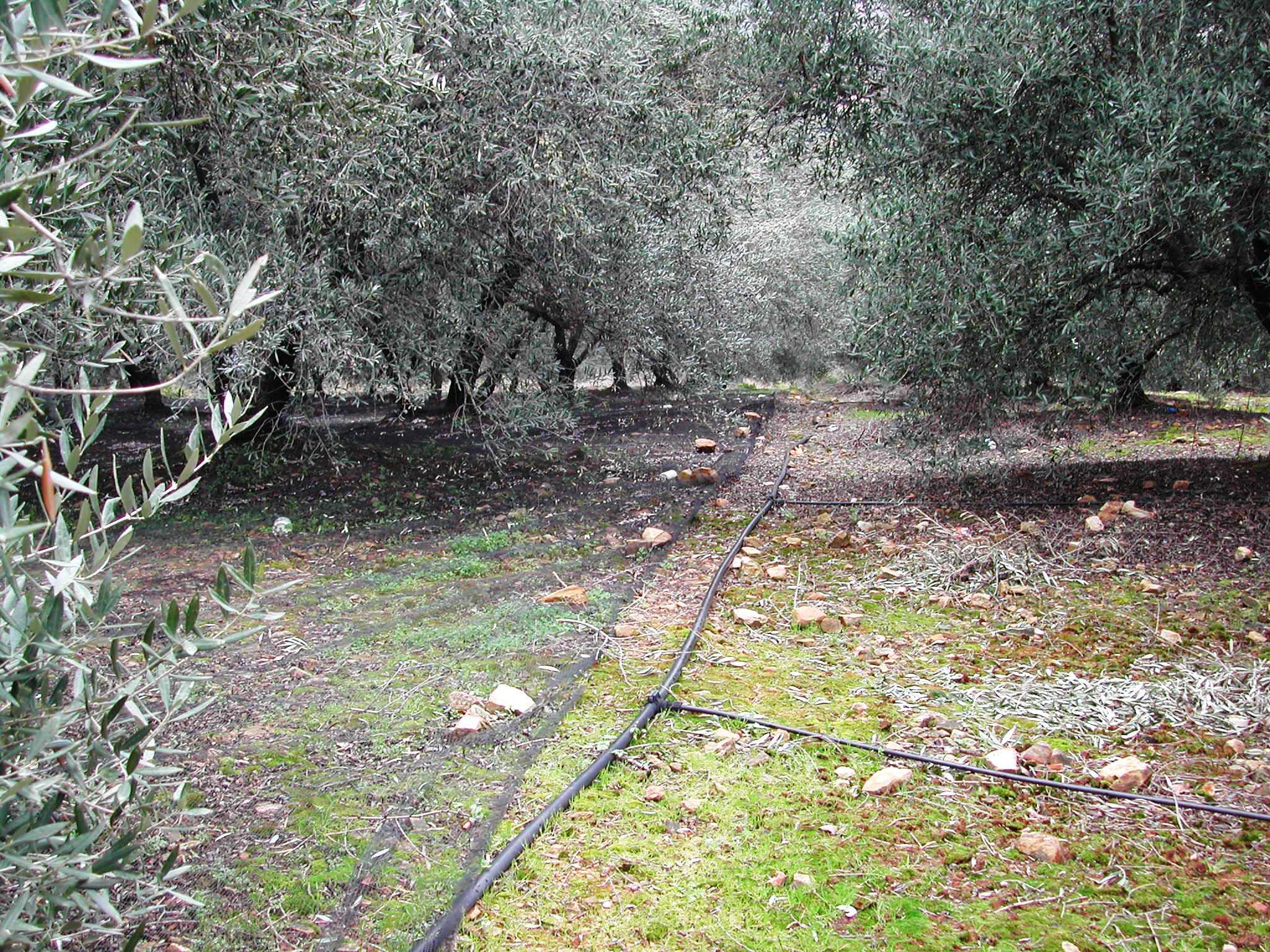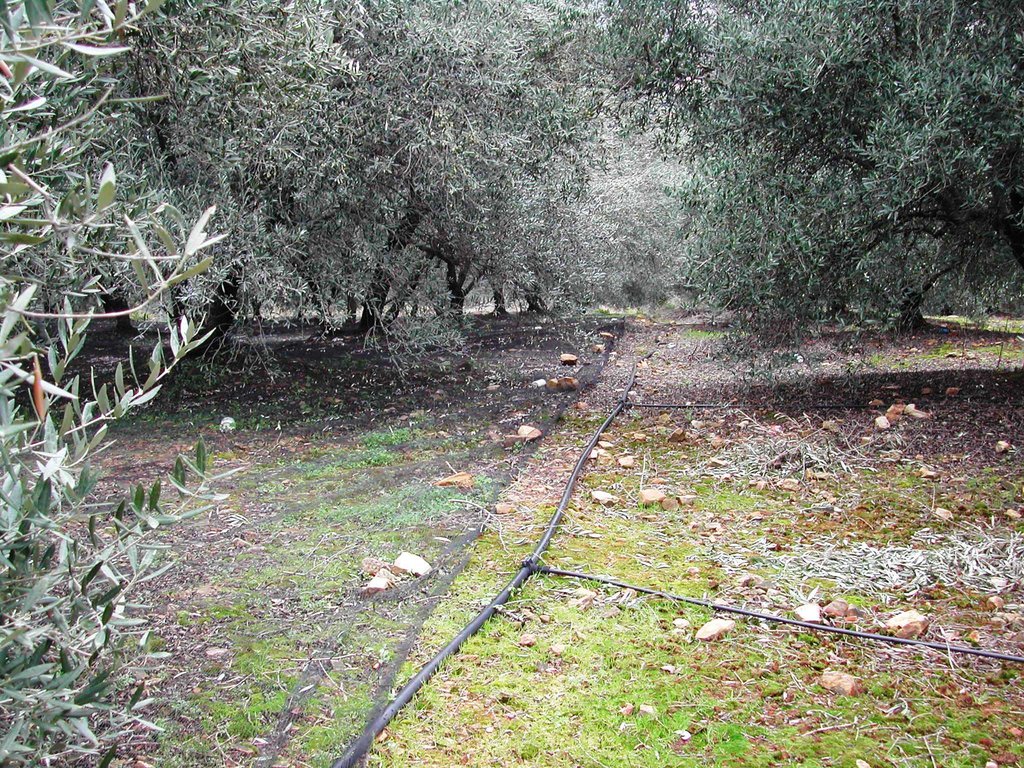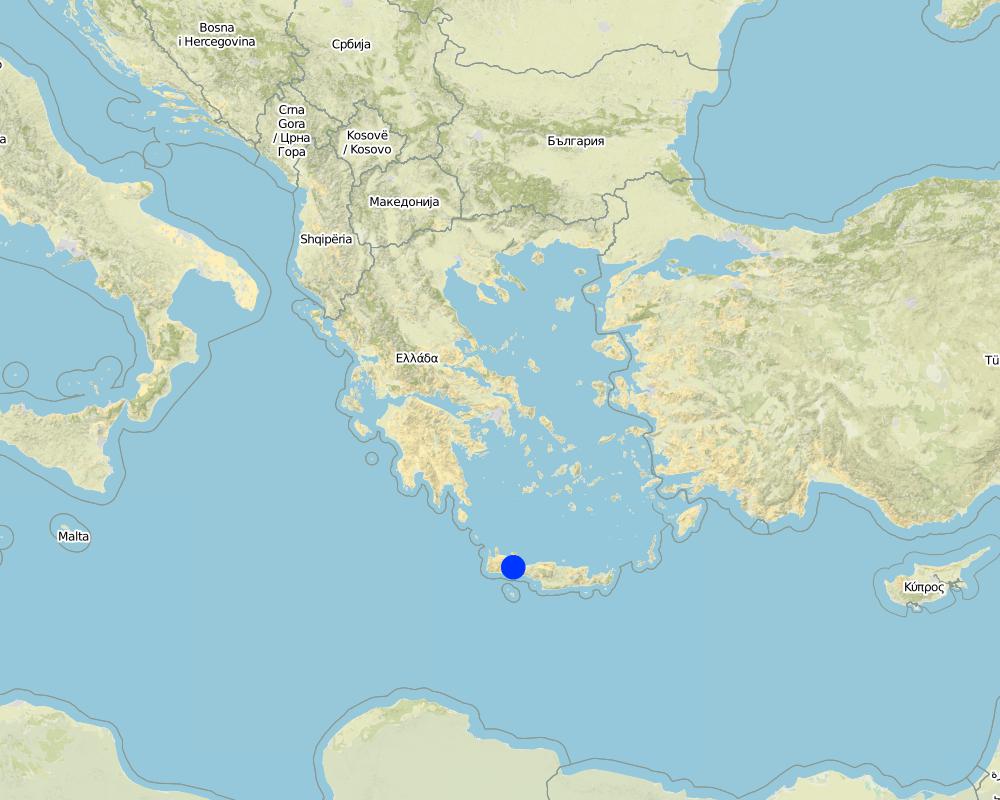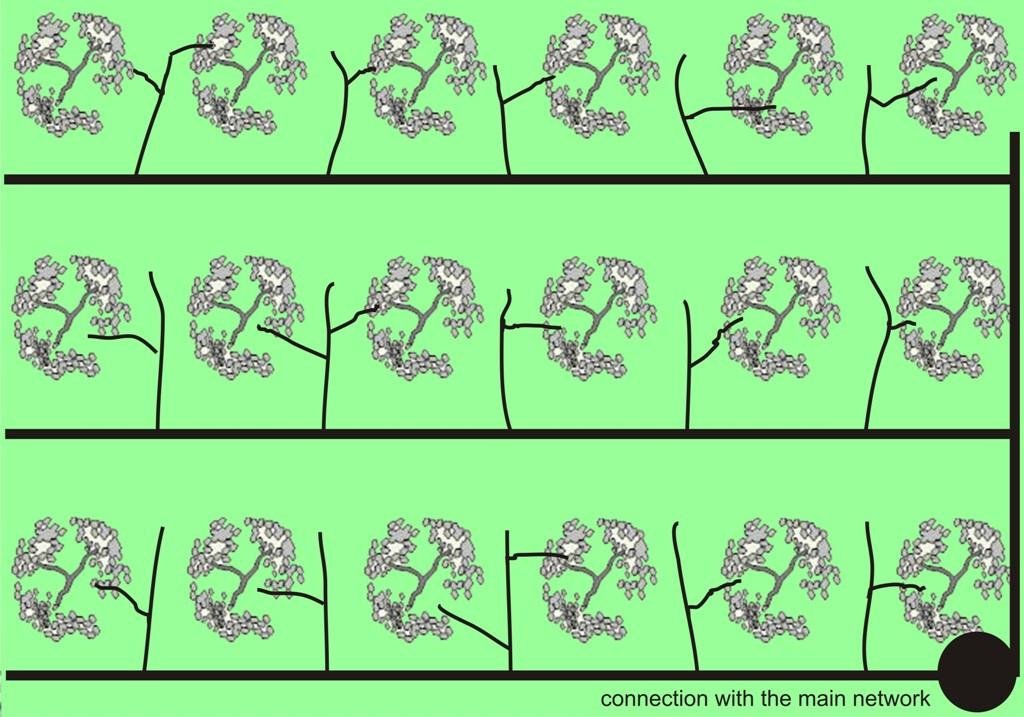Application of water by drip irrigation [希腊]
- 创建:
- 更新:
- 编制者: Costas Kosmas
- 编辑者: –
- 审查者: Fabian Ottiger, Alexandra Gavilano
Αρδευση με σταγονες
technologies_1456 - 希腊
查看章节
全部展开 全部收起1. 一般信息
1.2 参与该技术评估和文件编制的资源人员和机构的联系方式
SLM专业人员:
Bardoulaki-Spanoudaki G
Organization for the Development of Western Crete OADYK Agia, Chania
希腊
有助于对技术进行记录/评估的机构名称(如相关)
Agricultural University of Athens (AUAb) - 希腊有助于对技术进行记录/评估的机构名称(如相关)
Organization for the Development of Western Crete (OADYK) - 希腊1.3 关于使用通过WOCAT记录的数据的条件
编制者和关键资源人员接受有关使用通过WOCAT记录数据的条件。:
是
1.5 参考关于SLM方法(使用WOCAT记录的SLM方法)的调查问卷
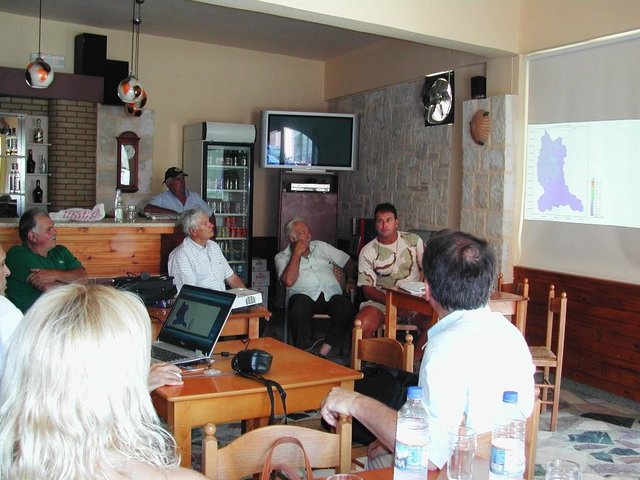
Sustainable use of water [希腊]
Sustainable use of water
- 编制者: Costas Kosmas
2. SLM技术的说明
2.1 技术简介
技术定义:
Drip irrigation, also known as trickle irrigation is a method which minimizes the use of water and fertilizer by allowing water to drip slowly to the roots of plants, either onto the soil surface or directly onto the root zone, through a network of valves, pipes, tubing, and emitters.
2.2 技术的详细说明
说明:
Irrigation is very important for increasing crop yields in arid, semi-arid and dry sub-humid climates. The area of irrigated land has increased more than twice in the last decades in the study areas. In recent years, the considerable reduction of winter and autumn rainfall has caused a serious lack of water resources. The production of the various crops is substantially reduced if water is not provided during the summer period.
The high demands for water consumption or other economic activities have increased the price of water, forcing up the cost of agricultural production. In addition, in many cases, low quality (with high electrical conductivity) water is used for irrigation. The need for intensification of agriculture to meet the high cost of production, the use of poor quality of water, the lack of drainage systems are in many cases responsible for soil degradation resulting from water logging, salinization, alkalinization, and soil erosion.
Purpose of the Technology: Drip or trickle irrigation achieves the highest irrigation efficiency since about 90% of the applied water is available to the plants. This SWC technology is especially suitable for watering trees or other large plants keeping strips among trees dry. Application of water by drip irrigation can be considered more as more efficient method using low quality of irrigation water. Irrigation water of high salt content can be applied in higher quantities in spots leaching salts to deeper soil layers. Drip irrigation can be applied in any type of soil from coarse- and fine-textured and without any limitation to slope gradient requiring little labour during installation.
Establishment / maintenance activities and inputs: In the study area of Chania trickle irrigation system includes mainly three branches from the outlet of main water network transportation system to the application in the trees. The last branch consists of plastic tube 12 to 32 mm in diameter that lies either on or just below the soil surface and applies the water either through small holes in the line or through emitter nozzle.
Natural / human environment: In recent years the increasing awareness of farmers on issues relating to the sustainability of the environment and conservation of water by promoting SWC technologies has led to widespread of use of drip irrigation in the area of Crete and in many other parts of the Country. The categorization of the specific SWC technology according to the WOCAT questionnaire is defined as: CtWtA3.
2.3 技术照片
2.5 已应用该技术的、本评估所涵盖的国家/地区/地点
国家:
希腊
区域/州/省:
Kidonia
有关地点的进一步说明:
Chania Crete
注释:
Total area covered by the SLM Technology is 480 km2.
Map
×2.7 技术介绍
详细说明该技术是如何引入的:
- 在实验/研究期间
3. SLM技术的分类
3.2 应用该技术的当前土地利用类型

农田
- 乔木与灌木的种植
乔木和灌木种植 - 指定作物:
- 橄榄树
具体说明:
Longest growing period in days: 120Longest growing period from month to month: March to JuneSecond longest growing period in days: 150Second longest growing period from month to month: March to June
注释:
Major land use problems (compiler’s opinion): availability of irrigation water, loss of water in the network, conflicts between districts and economic sectors of tourism and agriculure
Major land use problems (land users’ perception): availability of irrigation water, conflicts between districts and economic sectors of tourism and agriculure
Livestock is grazing on crop residues
3.4 供水
该技术所应用土地的供水:
- 混合雨水灌溉
3.5 该技术所属的SLM组
- 灌溉管理(包括供水、排水)
3.6 包含该技术的可持续土地管理措施

农艺措施
- A3:土壤表面处理

结构措施
- S11:其它
注释:
Main measures: agronomic measures
Secondary measures: structural measures
Type of vegetative measures: in blocks
3.7 该技术强调的主要土地退化类型

水质恶化
- Ha:干旱化
注释:
Main type of degradation addressed: Ha: aridification
Main causes of degradation: disturbance of water cycle (infiltration / runoff) (lack of water), education, access to knowledge and support services (lack of knowledge)
Secondary causes of degradation: over abstraction / excessive withdrawal of water (for irrigation, industry, etc.) (salinization)
3.8 防止、减少或恢复土地退化
具体数量名该技术与土地退化有关的目标:
- 防止土地退化
注释:
Secondary goals: prevention of land degradation
4. 技术规范、实施活动、投入和成本
4.1 该技术的技术图纸
技术规范(与技术图纸相关):
In the study area of Chania trickle irrigation system includes mainly three branches from the outlet of main water network transportation system to the application in the trees. The last branch consists of plastic tube 12 to 32 mm in diameter that lies either on or just below the soil surface and applies the water either through small holes in the line or through emitter nozzles.
Location: Kasteli. Chania
Date: March 2007
Technical knowledge required for land users: moderate (system installation requirements)
Main technical functions: improvement of ground cover
Secondary technical functions: increase in organic matter, increase of biomass (quantity)
In blocks
Vegetative material: C : perennial crops
Number of plants per (ha): 250
Vertical interval between rows / strips / blocks (m): 5
Spacing between rows / strips / blocks (m): 5
Vertical interval within rows / strips / blocks (m): 5
Width within rows / strips / blocks (m): 4
Perennial crops species: olives
Slope (which determines the spacing indicated above): 15.00%
Gradient along the rows / strips: 15.00%
Structural measure: irrigation system
Spacing between structures (m): 8
Construction material (other): plastic, plastic tubes 12-32 mm in diameter
Other type of management: Water distribution among farmers, water is provided under the control of local authorities
作者:
C. Kosmas
4.3 技术建立活动
| 活动 | 时间(季度) | |
|---|---|---|
| 1. | planting the olive trees | 2 days/ha |
| 2. | transporting plastic tubes | once during installation |
| 3. | Whole system of tubes, filters and system of fertilizers application | once during installation |
| 4. | Main network of irrigation system | once per year |
4.4 技术建立所需要的费用和投入
| 对投入进行具体说明 | 单位 | 数量 | 单位成本 | 每项投入的总成本 | 土地使用者承担的成本% | |
|---|---|---|---|---|---|---|
| 劳动力 | >Installation | ha | 1.0 | 350.0 | 350.0 | |
| 设备 | Tools | ha | 1.0 | 1650.0 | 1650.0 | |
| 技术建立所需总成本 | 2000.0 | |||||
| 技术建立总成本,美元 | 2000.0 | |||||
注释:
Duration of establishment phase: 0.1 month(s)
Life span of the irrigation network: 20 years
4.5 维护/经常性活动
| 活动 | 时间/频率 | |
|---|---|---|
| 1. | cleaning filters and replacing destroyied tubes | 3 hours every year/ha |
| 2. | Checking outlets and conectors | once per year |
| 3. | Control of network for loss of irrigation water | once per year |
4.6 维护/经常性活动所需要的费用和投入(每年)
| 对投入进行具体说明 | 单位 | 数量 | 单位成本 | 每项投入的总成本 | 土地使用者承担的成本% | |
|---|---|---|---|---|---|---|
| 劳动力 | Labour | ha | 1.0 | 10.0 | 10.0 | |
| 设备 | Tools | ha | 1.0 | 50.0 | 50.0 | |
| 技术维护所需总成本 | 60.0 | |||||
| 技术维护总成本,美元 | 60.0 | |||||
注释:
Machinery/ tools: hand tools, System of applying fertilizers through the irrigation water, filters for keeping various solid materials
per hectare of land affected
4.7 影响成本的最重要因素
描述影响成本的最决定性因素:
the reguired materials (tubes, filters, etc)
5. 自然和人文环境
5.1 气候
年降雨量
- < 250毫米
- 251-500毫米
- 501-750毫米
- 751-1,000毫米
- 1,001-1,500毫米
- 1,501-2,000毫米
- 2,001-3,000毫米
- 3,001-4,000毫米
- > 4,000毫米
有关降雨的规范/注释:
With six months of dry period
农业气候带
- 半湿润
- 半干旱
Thermal climate class: temperate
5.2 地形
平均坡度:
- 水平(0-2%)
- 缓降(3-5%)
- 平缓(6-10%)
- 滚坡(11-15%)
- 崎岖(16-30%)
- 陡峭(31-60%)
- 非常陡峭(>60%)
地形:
- 高原/平原
- 山脊
- 山坡
- 山地斜坡
- 麓坡
- 谷底
垂直分布带:
- 0-100 m a.s.l.
- 101-500 m a.s.l.
- 501-1,000 m a.s.l.
- 1,001-1,500 m a.s.l.
- 1,501-2,000 m a.s.l.
- 2,001-2,500 m a.s.l.
- 2,501-3,000 m a.s.l.
- 3,001-4,000 m a.s.l.
- > 4,000 m a.s.l.
5.3 土壤
平均土层深度:
- 非常浅(0-20厘米)
- 浅(21-50厘米)
- 中等深度(51-80厘米)
- 深(81-120厘米)
- 非常深(> 120厘米)
土壤质地(表土):
- 中粒(壤土、粉土)
表土有机质:
- 高(>3%)
- 中(1-3%)
如有可能,附上完整的土壤描述或具体说明可用的信息,例如土壤类型、土壤酸碱度、阳离子交换能力、氮、盐度等。:
Soil fertility is very high-medium
Soil drainage/infiltration is good
Soil water storage capacity is high-very high
5.4 水资源可用性和质量
地表水的可用性:
好
关于水质和水量的注释和进一步规范:
Ground water table: 5-50 m, > 50 m
Water quality (untreated): good drinking water, for agricultural use only (irrigation)
5.5 生物多样性
物种多样性:
- 高
5.6 应用该技术的土地使用者的特征
生产系统的市场定位:
- 混合(生计/商业)
非农收入:
- 低于全部收入的10%
相对财富水平:
- 平均水平
- 丰富
个人或集体:
- 个人/家庭
机械化水平:
- 机械化/电动
性别:
- 男人
说明土地使用者的其他有关特征:
Land users applying the Technology are mainly common / average land users
Difference in the involvement of women and men: Women in rural areas are involved in other type of work
Population density: 10-50 persons/km2
Annual population growth: 1% - 2%
5% of the land users are rich (cost for buying materials).
55% of the land users are average wealthy.
Off-farm income specification: working in tourist business
5.7 应用该技术的土地使用者使用的平均土地面积
- < 0.5 公顷
- 0.5-1 公顷
- 1-2 公顷
- 2-5公顷
- 5-15公顷
- 15-50公顷
- 50-100公顷
- 100-500公顷
- 500-1,000公顷
- 1,000-10,000公顷
- > 10,000公顷
这被认为是小规模、中规模还是大规模的(参照当地实际情况)?:
- 小规模的
5.8 土地所有权、土地使用权和水使用权
土地所有权:
- 个人,有命名
土地使用权:
- 租赁
- 个人
用水权:
- 社区(有组织)
- 个人
5.9 进入服务和基础设施的通道
技术援助:
- 贫瘠
- 适度的
- 好
市场:
- 贫瘠
- 适度的
- 好
道路和交通:
- 贫瘠
- 适度的
- 好
金融服务:
- 贫瘠
- 适度的
- 好
6. 影响和结论性说明
6.1 该技术的现场影响
社会经济效应
生产
作物生产
SLM之前的数量:
1500 kg/ha
SLM之后的数量:
2000 kg/ha
土地管理
注释/具体说明:
Cultivation of the land is hindered by the irrigation network
水资源可用性和质量
灌溉用水的可用性
灌溉用水的质量
收入和成本
农业投入费用
农业收入
SLM之前的数量:
4500 euro/ha
SLM之后的数量:
5800 euro/ha
工作量
社会文化影响
文化机会
社会经济弱势群体的情况
Improved livelihoods and human well-being
注释/具体说明:
Significant environmental benefit from the rational use of irrigation water
生态影响
土壤
土壤水分
盐度
生物多样性:植被、动物
生物量/地上C
其它生态影响
Waste
注释/具体说明:
environmental pollution due to presence of plastics not easily recycled
6.2 该技术的场外影响已经显现
水资源可用性
6.3 技术对渐变气候以及与气候相关的极端情况/灾害的暴露和敏感性(土地使用者认为的极端情况/灾害)
气候有关的极端情况(灾害)
水文灾害
| 该技术是如何应对的? | |
|---|---|
| 比较和缓的(河道)洪水 | 不好 |
注释:
Control of flooding by adjusting river bed
6.4 成本效益分析
技术收益与技术建立成本相比如何(从土地使用者的角度看)?
短期回报:
积极
长期回报:
积极
技术收益与技术维护成本/经常性成本相比如何(从土地使用者的角度看)?
短期回报:
积极
长期回报:
积极
6.5 技术采用
如若可行,进行量化(住户数量和/或覆盖面积):
3850
在所有采用这项技术的人当中,有多少人是自发的,即未获得任何物质奖励/付款?:
- 11-50%
注释:
65% of land user families have adopted the Technology with external material support
2200 land user families have adopted the Technology with external material support
35% of land user families have adopted the Technology without any external material support
1650 land user families have adopted the Technology without any external material support
There is a moderate trend towards spontaneous adoption of the Technology
6.7 该技术的优点/长处/机会
| 土地使用者眼中的长处/优势/机会 |
|---|
|
Increase crop production in some cases up to 50% How can they be sustained / enhanced? providing more water |
| 编制者或其他关键资源人员认为的长处/优势/机会 |
|---|
|
Technologies on conserving soil and water resources and combating desertification in Crete are mainly related to land management. Olive groves are widely expanded in the island due to the importance of olive oil as one of the essential material for daily human food needs. Furthermore, olive groves can survive under adverse climatic and soil conditions supporting a significant farmer’s income under relatively low labour. Land management practices have been adopted in the area based on tradition and transfer knowledge by the local institutes and specialists. In addition, irrigation of the land by the drip system is considered as a very promising technique for conserving water resources in the area. Land terracing is a human intervention in sloping semi-natural landscapes, which have suffered losses, to some degree, in their sustainability and resilience. How can they be sustained / enhanced? by providing additional water resources in the area (build a water reservoir) |
6.8 技术的弱点/缺点/风险及其克服方法
| 土地使用者认为的弱点/缺点/风险 | 如何克服它们? |
|---|---|
| High cost for buying materials, better education | subsidizing materials, technology transfer |
| 编制者或其他关键资源人员认为的弱点/缺点/风险 | 如何克服它们? |
|---|---|
| increased cost for the first installation | subsidizing the system |
7. 参考和链接
7.1 信息的方法/来源
链接和模块
全部展开 全部收起链接

Sustainable use of water [希腊]
Sustainable use of water
- 编制者: Costas Kosmas
模块
无模块


